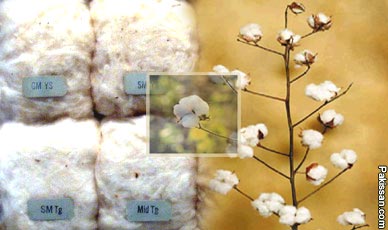|
Main Page
|
![]() |
Cotton crop estimate lower
than targeted
By Ahmad Fraz Khan
 PAKISTAN
is going to miss its cotton target for the fifth
consecutive year this season. Islamabad has revised its
production estimate from 13.2 million bales to 12
million. However, the official forecast is higher than
the estimate of the Pakistan Cotton Ginning Association
(PCGA) which has put the figure lower, at 11.7 million
bales. PAKISTAN
is going to miss its cotton target for the fifth
consecutive year this season. Islamabad has revised its
production estimate from 13.2 million bales to 12
million. However, the official forecast is higher than
the estimate of the Pakistan Cotton Ginning Association
(PCGA) which has put the figure lower, at 11.7 million
bales.
Though the crop in Punjab is recovering from massive
virus (CLCV) attack in the last two months, the extent
of its recovery is difficult to gauge at this stage.
It would largely depend on the farmers’ behaviour;
whether they allow enough time to the resurgent crop to
mature, and risk delaying wheat sowing – the most secure
investment in the farming sector at this stage.
The Punjab Agriculture Department had been pressing
cotton farmers to keep applying urea and other nutrients
so that the crop survives the CLCV attack and re-grows.
The regrowth has started and the plant size in most of
the areas has reached two to 2.5 feet – al most half of
normal height. Most of the crop is thus back to square
one: these plants would take time to develop branches,
flowers, bowls and canopy – a three month process, which
would take the crop into late December or early January
and eat into wheat sowing time span. The farmers would
only wait if the cotton rates remain high. But in that
case, the country would suffer on the wheat front.
If the rates drop, the farmers would plough up the
cotton to go for wheat, leaving the country in a deficit
of three million bales short, requiring import of Rs60
billion at the current price factor. The country would
thus either lose on cotton (cash crop) or on food
security (wheat) – a precarious condition either way.
There is a host of official explanations of what went
wrong to the crop this year, including inclement
weather, massive attack by the cotton curl leave virus (CLCV),
absence of any virus resistant variety, pesticides
failure and uncertain genetic material. This is fifth
year running when the target has been missed. All these
years have had different reasons for crop failure, and,
to make the matter worse, none of them has been
addressed so far. The government simply does not seem to
have a policy for a crop that contributes to 70 per cent
of exports.
One of the permanent causes of crop failure has been the
seed sector, which, unfortunately, still remains as
neglected as it had been five years ago. Over these five
years, the share of so-called Bt cotton seed, which is
at the heart of current crisis, has risen from a paltry
10 per cent to 70 per cent. Interestingly, none of the
33 varieties of Bt cottonseed, being sold in the market,
is approved one. The situation is allowed to prevail
despite the fact that a recent study by the Punjab
government revealed that only eight of 33 marketed
varieties have Bt expression in them. The rest were
fake.
The government has neither approved any Bt cotton
variety nor enacted laws to check the fake ones. The
officially approved 16 traditional varieties are sown
only on 20 per cent of 3.2 million hectors.
No one really knows what is being sown in the name of Bt
cotton. Since no seed has been approved, naturally no
protocol – training of farmers on how to grow and
protect the crop – has been developed. The BT gene
normally disappears from seeds within three years and
exposes the crop to every kind of disease.
No official knows for sure for how many years a
particular seed is being sown, and what are its
strengths and weaknesses. These factors have made the
crop a “total uncertainty.” Another area, where the
government has failed is the pesticides front. This
year, none of the available pesticides has been able to
check the virus attack in any part of Punjab. The sheer
extent of damage tells the story of pesticides failure.
According to press reports, the virus affected 90 to 95
per cent crop in districts Burewala, Khanewal,
Leyah,Vehari and adjoining areas. In Lodhran, Rajanpur,
Muzafargarh and Pakpatten, the damage was around 90 per
cent. In D. G. Khan, Khanewal and Bahawalpur about 70
per cent hot spots were found and Faisalabad, Rahimyar
Khan, Mianwali, Okara, and Bahawalnagar witnessed 40 to
55 per cent infection. No where in these districts
application of pesticides succeeded. To make the matter
worse, the virus has also reached non-core areas likes
Faisalabad, generating more fears.
The situation shows vulnerability of the crop and the
level of government preparedness in dealing with
emergencies. So far, officially suggested recipe has
been application of fertiliser and nutrients so that the
crop re-grows once the virus (CLCV) completes its
lifecycle. The re-grown crop now has its cost-benefit
ratio for farmers and the country.
Over the past five years, the federal and provincial
governments simply looked other way as the Bt cotton
share in cultivation multiplied, apparently oblivious of
its rising costs in the absence of required official
intervention.
Courtesy: The DAWN |
|
Pakissan.com;
|
|
|